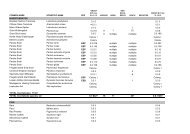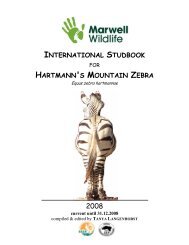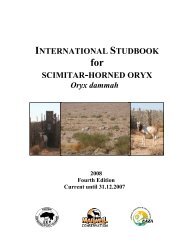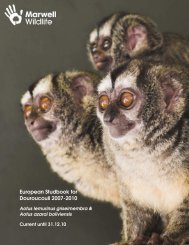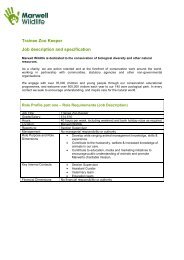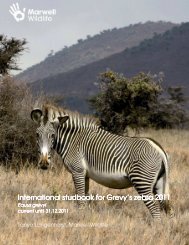Hartmann's mountain zebra studbook 2011 - Marwell Zoo
Hartmann's mountain zebra studbook 2011 - Marwell Zoo
Hartmann's mountain zebra studbook 2011 - Marwell Zoo
You also want an ePaper? Increase the reach of your titles
YUMPU automatically turns print PDFs into web optimized ePapers that Google loves.
Hybridisation<br />
There have long been rumours of hybridisation between <strong>mountain</strong> <strong>zebra</strong> and plains <strong>zebra</strong> (Equus<br />
quagga burchellii) in Namibia and recent preliminary genetic analysis supports this possibility. My own<br />
interest started with observations of male <strong>mountain</strong> <strong>zebra</strong> becoming attached for long periods to<br />
particular breeding groups of plains <strong>zebra</strong>. This has been seen twice in NamibRand Nature Reserve<br />
and once on Gondwana Cañon Park, both areas where plains <strong>zebra</strong> have been re-introduced in<br />
recent times. In GCP the <strong>mountain</strong> <strong>zebra</strong> male was attached to one breeding group and rejoined it,<br />
even after mingling with other groups at water holes. He was subordinate to the plains <strong>zebra</strong> group<br />
stallion and this is also likely in the case of at least one male in NamibRand. This latter male was<br />
repeatedly injured, presumably in combat with a plains <strong>zebra</strong> male. No obvious hybrids have been<br />
seen in either area and these observations suggest that gene flow from male <strong>mountain</strong> <strong>zebra</strong> to<br />
female plains <strong>zebra</strong> may be unlikely because male plains <strong>zebra</strong> are larger and able to defend their<br />
females. Despite this, the observations show a remarkable behavioural attachment between<br />
individuals of the two species which raises the possibility of hybrid mating. A greater danger could<br />
arise when males compete for access to female <strong>mountain</strong> <strong>zebra</strong> because in this case the larger plains<br />
<strong>zebra</strong> stallions may win.<br />
In addition, there is regular ecological overlap. Mountain <strong>zebra</strong> and plains <strong>zebra</strong> have broadly distinct<br />
habitats but they often overlap. For example, in NamibRand plains <strong>zebra</strong> move up into the foothills of<br />
the Nubib <strong>mountain</strong>s in the late dry season as the grassland of the plains are depleted. And in<br />
Gondwana in early 2012, <strong>mountain</strong> <strong>zebra</strong> were moving down onto the plains near Holoogberg as the<br />
wet season green flush appeared and, possibly, as the <strong>mountain</strong> <strong>zebra</strong> population expands. Where<br />
the two species overlap, they often occur at the same water holes. They never drink at the same time<br />
(in my experience) but may do so within a few minutes of each other and water holes are clearly<br />
places where these water-dependent species may start the process of forming social bonds.<br />
Of more immediate importance is the situation in Etosha National Park. Hybridisation has been<br />
reported there for some time and an earlier student (who unfortunately did not finish his studies)<br />
photographed animals that appear to be hybrids. I visited Etosha last October and spoke to a warden<br />
about the hybridisation issue. His view was that there were probably many hybrids in the western part<br />
of the park and that this may have come about because the normal western movements of <strong>mountain</strong><br />
<strong>zebra</strong> into the <strong>mountain</strong>ous areas to the west of the park may have been prevented when the<br />
boundary fence was erected. Hybrids reported elsewhere may also be partly due to restrictions of<br />
movement by fencing but this remains to be investigated.<br />
Clearly, there is an urgent need for targeted research into this problem with a view to designing<br />
appropriate management practices. Preliminary analysis of DNA collected in previous studies of <strong>zebra</strong><br />
in Etosha reveal some evidence for hybridisation between the two species; for example one plains<br />
<strong>zebra</strong> had ~30% genetic assignment to <strong>mountain</strong> <strong>zebra</strong> (Pauline Kamath, pers comm.). Hopefully, a<br />
wider genetic study to test these findings and explore the causes will start soon and, using an<br />
individual-based approach, I will be helping to look at the behavioural and ecological basis of mate<br />
choice across the two species.<br />
There are many unknowns at the moment. Mountain <strong>zebra</strong> and plains <strong>zebra</strong> have clearly remained<br />
separate in evolutionary time so why is a problem occurring now? Or are the hybrids confined to a<br />
hybrid zone that will not affect the main populations? We cannot answer these questions at the<br />
moment but the possibility that confinement and fencing is creating a new and potentially dangerous<br />
situation should be tested. Hybridisation may be occurring in the west of Etosha NP because the<br />
fence at the western end of Etosha prevents natural movements by <strong>mountain</strong> <strong>zebra</strong>, and thus<br />
ecological separation from plains <strong>zebra</strong>. The risk of hybridisation may also occur elsewhere in Namibia<br />
when plains <strong>zebra</strong> are introduced into enclosed farms in <strong>mountain</strong> <strong>zebra</strong> habitat; or reintroduced into<br />
areas which previously contained plains <strong>zebra</strong> but where spatial dynamics have been altered by<br />
fencing. Thus, in spite of the fact that some <strong>mountain</strong> <strong>zebra</strong> populations are increasing in Namibia, a<br />
AII





